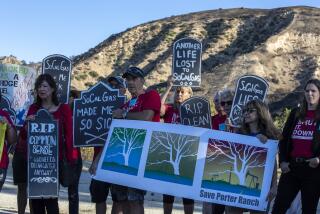U.S. lets BP keep well sealed for now
- Share via
Reporting from Los Angeles and Atlanta — The federal government has given BP the go-ahead to keep its well sealed for another day after concluding that, at least for now, there are no serious problems with the capping operation that has stopped the flow of oil into the Gulf of Mexico.
Federal officials have been conducting a delicate balancing act, relieved that BP has shut down the monster leak with a new cap but also worried that the seal could force oil out of the well hole into the seabed and create the equivalent of a deep-sea oil volcano.
Monitoring has revealed several “anomalies,” including a small leak in the cap seal and bubbles — believed to be natural gas — rising from the base of the blowout preventer. But Thad Allen, the national incident commander, said none were of great concern.
“There is no indication at this time ... of a significant problem in the well bore,” Allen said Monday. A seep about two miles from the wellhead is probably not related and the cap leak is not consequential, he said.
Allen also mentioned that scientists are discussing the possibility of using the cap to attempt another “top kill,” in which drilling mud would be injected into the damaged well to plug it. An earlier attempt was abandoned.
Still, Allen emphasized that questions remained about conditions of the deep-sea well and circumstances could quickly change.
“It would be very premature to say the well is shut in,” Allen said, adding that work continues on two relief bores that could enable BP to make the final fix. The first one is expected to reach the well at the end of the month, after which drilling mud and cement would be pumped into the well bottom to permanently plug it.
In the meantime, scientists are debating why pressure in the new cap did not rise as much as expected. One worrisome explanation is that the well bore is damaged, allowing oil to seep into adjacent rock and sand, where it could push up to the seabed. Another theory is that the oil reservoir has leaked so much crude into the gulf that its natural pressure has dropped.
“Continuing along with this test in 24-hour increments is absolutely the way for us to go forward,” BP Senior Vice President Kent Wells said in a Monday evening conference call with reporters. “It just allows us to clearly distinguish between whether we have a depleted reservoir or whether we have integrity in the well.”
Wells said BP was concerned initially that it would see a lower-than-expected pressure reading in the first six hours of the well test, a strong indicator of a leaky well bore. Now, he said, each additional day gives the company more confidence in the integrity of the well.
Wells said the idea of plugging the well with a new top kill was “very much in its infancy” and that experts were still studying whether it would be possible. With the new seal on the top of the well, mud could be pumped in at lower pressure and perhaps be more effective than the previous attempt, in which it was sent through valves on the blowout preventer at high pressure.
Allen said BP had agreed to an intense monitoring regimen, including visual inspections with its underwater robots, seismic and acoustic soundings of the seabed and the use of hydrophones to listen to the workings of the well itself. If necessary, the well would be opened and a collection system restarted to funnel captured oil to surface ships.
Rep. Edward J. Markey (D-Mass.), meanwhile, is concerned that the cap might preclude measurements of the amount of oil that has spewed since the April 20 explosion of the Deepwater Horizon drilling rig. A federal team of experts estimated the rate to be between 35,000 and 60,000 barrels a day. Markey has asked the Coast Guard and BP to conduct a more accurate test, but he said he was worried that might not be possible if the well were shut in.
Markey’s staff said a more accurate number is important because if BP’s actions are found to amount to gross negligence, the company could face a federal fine of $4,300 per barrel.
Allen said pressure readings from the cap operation and other data should provide enough information to formulate a good estimate.
Even if the spill is finally over, its effects could linger for a long time. The environmental group Greenpeace announced it was launching a ship, the Arctic Sunrise, on a three-month mission to “document the true impacts of the disaster on gulf marine life.”
The American Bird Conservancy said some cleanup efforts had done more harm than good to the gulf’s bird life. In a report released Monday, leaders of the nonprofit group said that during a six-day tour, they observed cleanup crews trampling beach roosting and nesting areas and saw noisy air-boats disturbing colonies of pelicans and terns.
The group also said near-shore oil skimming operations were not very effective, nor were “harbor” booms deployed to protect bird colonies. On a more positive note, the avian advocates said bird-cleaning efforts appeared to be working well and the spill’s overall effect on the gulf’s bird population “is not yet as bad as it could be.”
Boxall reported from Los Angeles and Fausset from Atlanta.
More to Read
Sign up for Essential California
The most important California stories and recommendations in your inbox every morning.
You may occasionally receive promotional content from the Los Angeles Times.














